
Making a Masterpiece
It has been said that the samurai's sword was his soul.
Perhaps this deep attachment had something to do with the
perfect melding of form and function found in the
katana, as the famous curved sword is known in Japan.
Invented a millennium ago, the katana remains a marvel of
aesthetic beauty and skillful engineering. While most bladed
weapons over the centuries were designed to either pierce or
slash, the katana's two different types of steel gave it
optimum qualities for both, making it a highly versatile
weapon in battle. Below, follow the steps that a master
Japanese swordsmith takes today to craft what is arguably the
most legendary of swords.—Rima Chaddha and Audrey Resutek
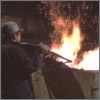

|
|
Smelting steel
The traditional katana sword is fashioned only from the
purest steel, which the Japanese call
tamahagane ("jewel steel"). Over three days and
three nights, smelters using ancient techniques shovel
roughly 25 tons of iron-bearing river sand and charcoal
into the mouth of a tatara, a rectangular clay
furnace built specifically to produce a single batch of
tamahagane. Composed of carbon, the charcoal is as much
a key ingredient in steel as a source of fuel for the
furnace. The tatara will reach temperatures of up to
2,500°F, reducing the iron ore to steel and yielding
about two tons of tamahagane. The highest quality
tamahagane can cost up to 50 times more than ordinary
steel made using modern methods.
|
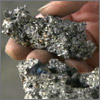

|
|
Dissolving carbon
While fired at high temperatures, the tamahagane is
never allowed to reach a molten state. This is to ensure
that just the right amount of carbon will dissolve into
the steel, and that the percentage of carbon will vary
throughout the tamahagane (between 0.5 and about 1.5
percent). Katana-makers use two types of tamahagane:
high-carbon, which is very hard and allows for a
razor-sharp edge, and low-carbon, which is very tough
and allows for shock absorption. A sword composed simply
of one kind of steel or the other would either dull too
quickly or be too brittle. On the third night of
smelting, when the tatara masters break open the clay
furnace to expose the tamahagane, they use the degree of
ease with which the pieces of newly made steel break
apart to discern their carbon content.
|


|
|
Removing impurities
The best pieces of tamahagane are sent to a swordsmith,
who heats, hammers, and folds the steel repeatedly in
order to further combine the iron and carbon, and to
draw out any remaining undissolved impurities, or
"slag." This step is as vital as it is tedious, because
if other elements besides iron and carbon remain in the
resulting sword, they will weaken it. Once the skilled
smith has removed all of the slag, he can judge the
carbon concentration of the tamahagane by the degree to
which it yields to his constant pounding. One expert has
likened eliminating slag from steel to squeezing liquid
from a very hard sponge.
|
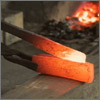

|
|
Forging the sword
After the smith hammers all slag from the tamahagane, he
heats the hard, high-carbon steel and shapes it into a
long, U-shaped channel. He then hammers the tough,
low-carbon steel, which he has shaped so it will make a
snug fit into the channel and forges the two metals
together. Both types of tamahagane are now exactly where
they need to be: the hard steel forms the sword's outer
shell and deadly blade, while the tough steel serves as
the katana's core. This perfect balance of properties is
what made the katana the samurai's most durable and
prized weapon.
|
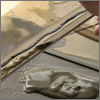

|
|
Coating the katana
While the katana's body is now complete, the
swordsmith's work is far from over. Just prior to firing
the sword a final time, he paints a thick, insulating
mixture of clay and charcoal powder onto the blade's
upper sides and dull back edge, leaving the sword's
sharp front edge only lightly coated. This serves both
to protect the blade and to give it its signature wavy
design called the hamon, which later polishing
will reveal. The swordsmith then places the katana back
into the fire to be heated to just below 1,500°F;
any hotter and the sword might crack during the next
step.
|
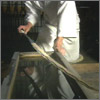

|
|
Curving the blade
Next, the smith pulls the katana from the fire and
plunges it into a trough of water in a rapid cool-down
process called "quenching." Because the sword's back
edge and inner core contain very little carbon, they can
contract more freely than the high-carbon steel at the
front edge of the blade. The difference in both the
degree and speed of contraction between the two forms of
tamahagane causes the sword to bend, creating the
distinctive curve. This is a tricky stage, in which as
many as one in three swords is lost.
|
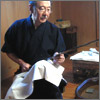

|
|
Polishing the blade
The katana, fully forged, now goes to a skilled sword
polisher, who may spend more than two weeks honing the
sword's razor-sharp edge. He meticulously rubs the blade
with a series of grinding and polishing stones, some
valued at more than $1,000 each and often passed down
through families for generations. Sometimes called
"water stones," these tools are typically composed of
hard silicate particles suspended in clay. As the clay
slowly wears away during use, more silicate particles
are revealed, guaranteeing excellent polishing quality
throughout the life of the stone. Each consecutive set
of polishing stones contains finer and finer silicate
particles and removes less and less of the steel.
|
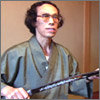

|
|
Adding final touches
In the final stage, metalworkers add a decorated guard
of iron or other metals at the sword's hilt. Next,
carpenters fit the weapon with a lacquered wooden
scabbard, which artisans then decorate with various
adornments. Fashioned from gold or exotic leathers and
stones, the katana's handle is as much of a work of art
as the blade itself. Finally, the katana is returned to
the swordsmith, who examines the weapon one last time.
It has taken 15 men nearly six months to create this
single katana sword. Though fit for a samurai warrior,
this sword will likely sell to art collectors for
hundreds of thousands of dollars.

|
|


We recommend you visit the
interactive version. The text to the left is provided for printing purposes.
|









